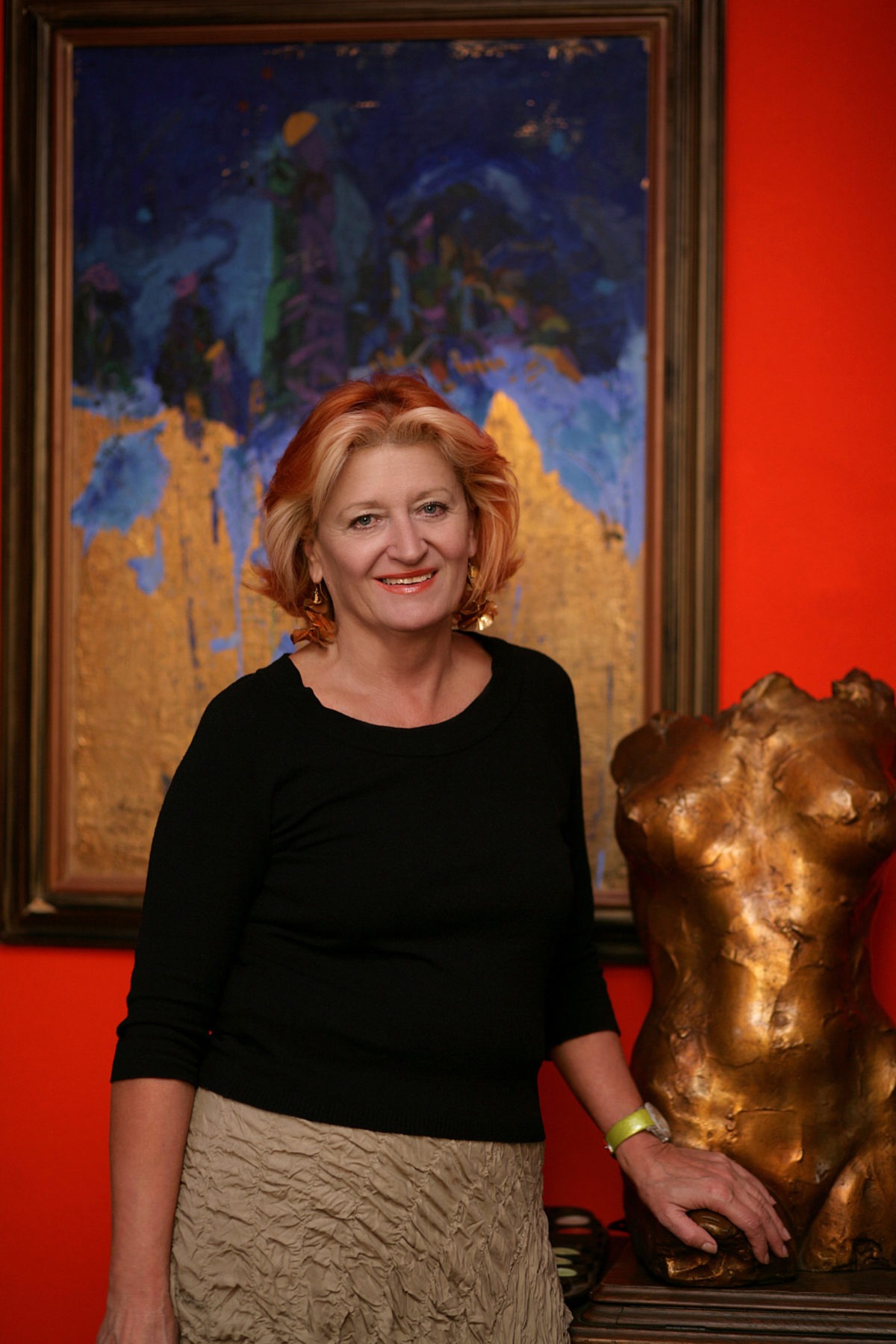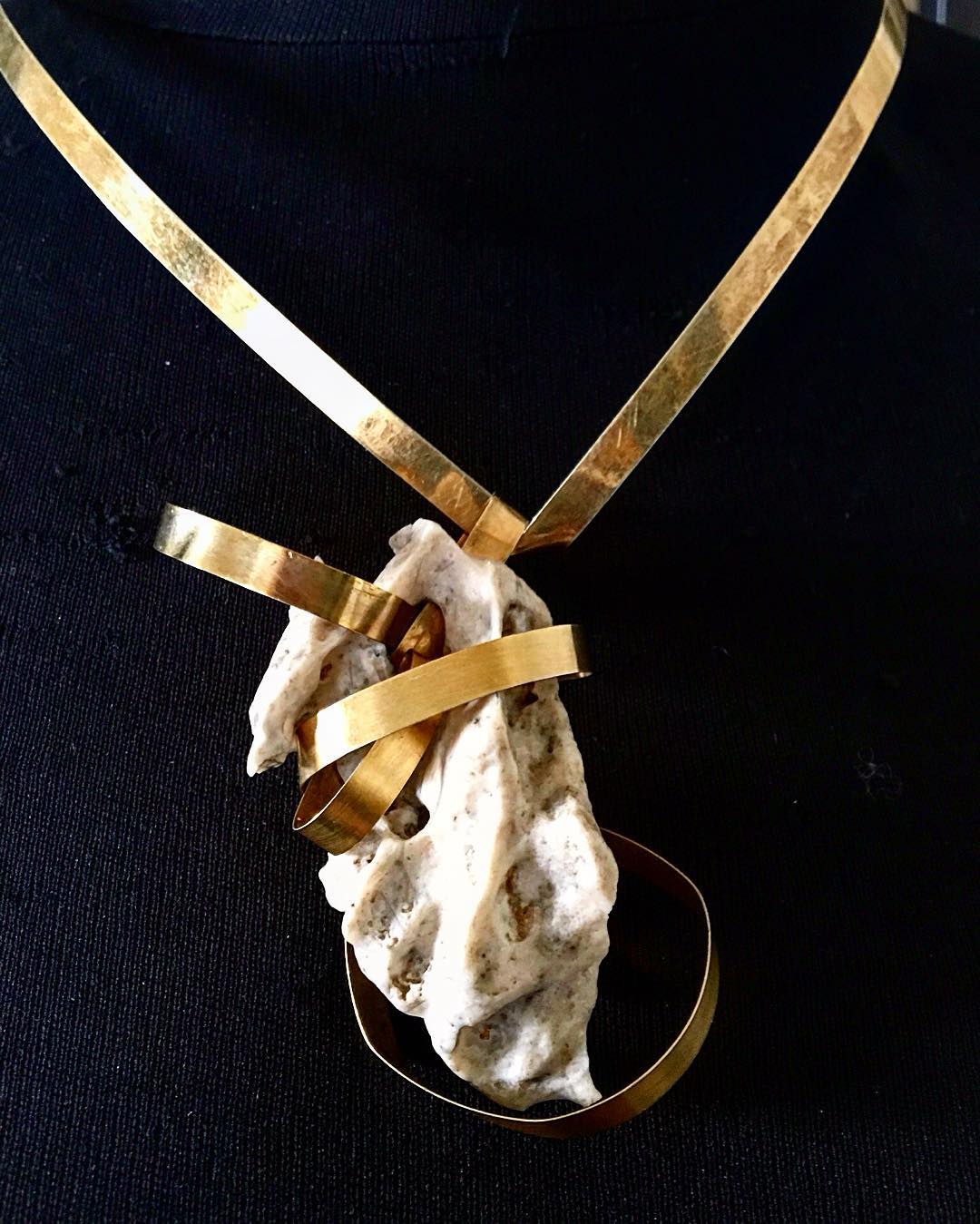
What They Say
A few of the many words that have been written about Maja Soric’s work.
I met Maja Sorić in May 2014 in London at the exhibition When Art Meets Jewellery. The blend of art and jewelry was enriched by the enthusiasm Maja had when presenting her jewelry and discovering the main source of inspiration when choosing and designing the materials. Unlike many other exhibitions in conventional galleries, at this exhibition, we could see the jewelry displayed as sculpture in a showcase, but at the same time experience its true function as it adorned the necks and hands of London ladies in the exclusive space of the private gallery. Only then has the artist’s inspiration been visible as with each movement of her body and earring tremble, the kinetic elegance of forms came to life, the suppleness of silver and gold was discovered and precious stones became even more precious.
Naturally formed topaz, onyx, turquoise or coral was so discretely installed into a frame that only just touched them. It was as if for a split second the rock had stopped the rhythm of a precious metal whose leaves and threads were interwoven into a glittery net of imaginative intertwining.
Sometimes, some objects we find in nature attract us and invite us to take them into our hands. At that very moment, a new life is born in the palm of our hands. So has this glittery crystal from the Egyptian desert attracted Maja and inspired her to put it into a golden and silver outfit. As a fashion designer cannot be successful if one doesn’t know how to both design and sew, so has Maja temporarily set the paints and canvas aside and enrolled in jewelry design school in Cairo. There she learned methods for designing traditional Egyptian jewelry as well as metal processing technics. As most artistic designs, so the jewelry design starts with a sketch, and Maja often makes paper, fabric, wax, or plastic models as well. She applies her knowledge of gold craftsmanship when cooperating with the goldsmith who performs the technical part of work, but she is with him from the beginning to the end. Once the jewelry leaves the workshop it comes to the hands of its designer, who finalizes her vision or performs an unforeseen intervention at the very end of the game.
In the last four years, she has often replaced her favorite silver weaves with long reticular tubes interwoven with delicate plastic threads in many colors. This new ‘urban material’ ordinarily used for fruit packaging when being exported to the world (and which is not really grown on Elysian Fields) attracts one’s attention with its flexibility, delicacy, and color. Perhaps she was even humorous when the colorful tubes, instead of being wrapped around the gentle skin of peach or apple were given a silver clutch or gold decorations just to be easily put around the gentle skin of a lady’s neckline.
Maja Sorić’s jewelry is timeless and universal, precious regardless of materials being used as the uniqueness of the design and the quality of the work are the only measure to success.
Flora Turner Vuceti
Art historian and critique, writer
I had an immense pleasure curating several of Maja’s exhibitions in Skenderija in Sarajevo, in the Sebastian Gallery in Dubrovnik, and the Visconti Art Gallery in Saint Germain, Paris. Each time it was different and interesting, however, I believe the Račić Gallery in Cvjetni trg as part of the Modern Gallery is the space worthiest of Maja’s art.
It is unknown what was crafted first in the history of mankind – the sculpture, the drawing, or jewelry. I believe that homo sapiens fulfilled his needs in a parallel way – by raising megaliths, binding stones, painting caves, and whatnot: There are the strings of mysterious earthly beads; The golden jewelry of Scythian women and warriors; chiseled golden collars of Egyptian rulers Nefertiti and Hatshepsut, the most refined petals of the crown of Alexander the Great. Not to mention the delicacy of the jewelry of ancient Rome which in its artistry and intricacy surpasses all known pompous phases of the Middle Ages, renaissance, baroque, rococo, and intellectualism of art nouveau.
Maja Sorić is a multitalented artist – however, she has decided to focus her talent towards the eternal necessity of the homo sapiens – the need to embellish oneself. And yet, she has given her jewelry the sculptural dimension or her sculptures the function of jewelry. She chose the interaction between a woman’s ear and her aerial sculptures. She has placed her vibrating forms around a woman’s neck. She has chosen attraction as one of the eternal motives, and the Woman is the intermediary between her extraordinary pieces and the world. The uniqueness of her sculptures is impressive and surprising. For the rest – we should ask men.
Jagoda Buic
Croatian visual artist best known for her monumental fiber art installations and tapestries
What should ideal artistic jewelry be like which in its form and material, as well as syntax and morphology reconciles the sometimes paradoxical tendencies of design form? Excluding the condition of being wearable, which prevents it to be categorized as a pure sculpture or small size object, that jewelry should be recognizable by its style, but also highlight the personality, mood, and spirit of the person wearing it. Therefore, high-quality jewelry speaks a lot about its author, but at the same time completes and respects its future owner.
Maja’s jewelry not only fulfills the above-mentioned conditions but her necklaces, bracelets, brooches, and rings act as autonomous artistic objects seeking their ideal human whole. In her forms, Maja Sorić integrates a variety of cultural influences, from ancient Egyptian forms, traditional jewelry of the desert, and the Red Sea to the habits of all Mediterranean women to adorn themselves with larger gold pieces.
Regardless of the way how her forms are designed in each different series of necklaces, brooches, and rings – in a linear way or by thinning the metal mass – the jewelry of this artist functions at two basic levels: as a shiny armor that emanates a golden glow (the Sun) or a playful, flexible artifact made of a multitude of wires and plates adapting themselves to the individual torso.
The interaction of precious metals with semi-precious stones and crystals (lapis lazuli, amethyst, turquoise, onyx) or amber, is not rigid and artificial, rather it is an interaction, a dialogue of two materials, where the author often plays the game of gravity and dynamic form composition. Semi-precious stones are minimally processed or refined, which makes them wearable every day on all occasions, therefore, they are not exclusive only for evening events.
The concept of rings being small defensive shields has embedded geometrically and lyrically abstract forms that introduce two-sided jewelry coding as the leitmotif of art jewelry: as woman’s decoration and defensive element. From a personal perspective, these associations instantly revoke the golden period of old Egypt and the middle ages in Europe where women were less helpless than we would think today.
Maja Sorić jewelry is extravagant, radiant, playful, unique, and representative, however, it does not flaunt itself with the extravagance of its body, and therein lies her mastery of balancing its design.
Sometimes in the tenderness of their design, Maja’s necklaces feature brittleness, especially in the line where colored fish scale is used – much as perforated metal may present the false idea of being transient and archaic, however, each of these pieces is exceptionally charged with the positive energy of the metal itself.
Having the vision to design contemporary lines of wearable jewelry, Maja Sorić integrated the magnificent sense of happiness and beauty in each necklace, ring, brooch, or bracelet. Without any pretentiousness or triviality, her artistic jewelry is, in its essence, self-conscious and emancipating and it shows us that every woman can feel like aristocracy – a feeling which is nowadays completely distorted, repressed, or given to those who are not entitled to it.
Iva Korbler
Art historian and Critique
From the instant that she embarked on the creative adventure of mastering art forms, Maja Sorić immersed herself into the magical world of the Orient, thus discovering its expressive force and artistic wealth which had enchanted so many artists of the traditional West. Being inspired by the authentic urban landscapes of Oriental souqs and bazaars, through the surreal chaos of Oriental urban architecture and everyday life, Maja Sorić developed her own sophisticated style as a landscaper of oriental scenery and panorama.
Perfecting her artistic intricacy in Jože Ciuha’s workshop, Maja Sorić emancipated herself from her Oriental markings and soared into the world of art informel and strong coloristic vibrations which signify the second phase of her work. Nevertheless, this world of one thousand and one nights encapsulates Maja’s return to the richness of the Orient, this time by designing avant-garde jewelry inspired by the ambient which is the source of her primary artistic focus.
In such a way her jewelry, assuming sculptural forms, is booming and flourishing, living its own artistic life and surpassing decorative women’s jewelry canon whose main function is emphasizing the allure of a woman wearing it as a sign of her taste, beauty, power and social status.
Maja’s jewelry is not at all like that as it lives its autonomous existence and is accentuated by its self-conscious aesthetic value, giving its potential owner the novel dimension reserved for devotees of pure artistic form. Maja’s experience of Egypt in which Mountolive, one of the four main characters from Darrel’s ‘The Alexandria Quartet’ relives his aesthetical ascent, is embodied in this pharaonic incarnation, through all of its dimensions and artistic significance, her jewelry is truly unique and not intended for mass consumption, but to delight the highest standards of devoted aesthetes.
Damir Grubisa, Ph.D.
Ambassador, Professor at American University Roma
The beauty of Maja Sorić’s sculpture jewelry lies in the essence of eastern and western culture being intertwined. Maja’s expression reflects the western culture as well as the rigidity of its design, which is simultaneously irresistibly charming, interwoven with eastern warmth, form, and audacity.
Whether in Paris, Beirut, Cairo, Venice, Rome, or Dubrovnik, her jewelry always sparks great attention.
The pieces of jewelry that Maja forges become sculptures in their own right and the precious stones, turquoise or Brazilian amethyst, or even the most ordinary stones from the desert are so intrinsically beautiful that they can be worn by anyone. A long-necked and tall supermodel, an African or Scandinavian, an Arabian princess, a red-headed Hollywood actress, all become enchanted by the rhythm and autonomy of unique materials which reflect the dazzling soul of the wearer and the full value of Maja’s own design and sparkle.
Maja’s jewelry is so courageous and daring that her artifacts are not merely ornaments, they are sculptures to outlive the ages.
It is essential to highlight that Maja’s artifacts embrace European culture, eastern enchantment, and the desert enigma. What Maja creates is not fashion jewelry, it is the archaic ornament that stems from the creation of a woman. The raw and primal essence of femininity. Sculptures of women from prehistoric ages depict jewelry and within ancient tombs, exquisite artifacts have been found highlighting the glory of womanhood and the eternal quest for the beautiful. Like the artist that she is, Maja Sorić is constantly conversing with the living sculpture, the true form of being a woman. This conversation has unpredictable revelations and the final outcome manifests itself on the bodies of her discerning clientele and the graceful and dignified manner in which the two interweave themselves. Woman and jewel become one. Maja ventures daringly through the dialogue between dazzling inorganic matter and the smooth organic movement of a woman’s body.
Ratko Ivekovic
Maja Soric’s Favorite Renaissance man and a true critic
